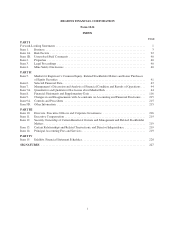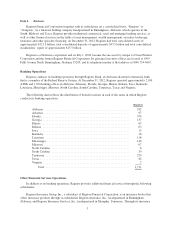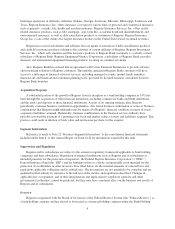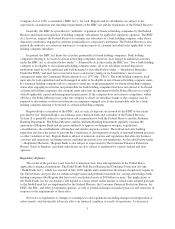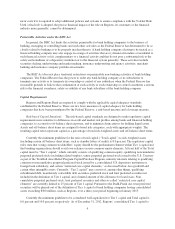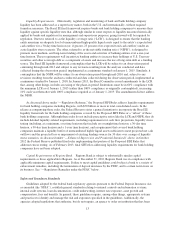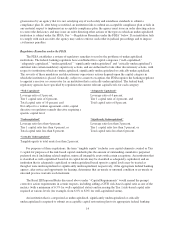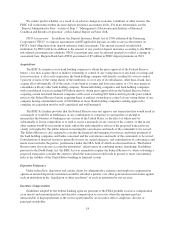Regions Bank 2012 Annual Report Download - page 26
Download and view the complete annual report
Please find page 26 of the 2012 Regions Bank annual report below. You can navigate through the pages in the report by either clicking on the pages listed below, or by using the keyword search tool below to find specific information within the annual report.risk-adjusted assets and Total capital to risk-adjusted assets ratios were 12.00 percent and 15.38 percent,
respectively. The elements currently comprising Tier 1 capital and Tier 2 capital and the minimum Tier 1 capital
and Total capital ratios may be subject to change in the future, as discussed in greater detail below. The risk-
based capital rules state that the capital requirements are minimum standards based primarily on broad credit-risk
considerations and do not take into account the other types of risk a banking organization may be exposed to
(e.g., interest rate, market, liquidity and operational risks).
Basel I and II Standards. Regions currently calculates its risk-based capital ratios under guidelines
adopted by the Federal Reserve based on the 1988 Capital Accord (“Basel I”) of the Basel Committee on
Banking Supervision (the “Basel Committee”). In 2004, the Basel Committee published a new set of risk-based
capital standards (“Basel II”) to revise Basel I. Basel II provides two approaches for setting capital standards for
credit risk—an internal ratings-based approach tailored to individual institutions’ circumstances and a
standardized approach that bases risk-weighting on external credit assessments to a much greater extent than
permitted in the existing risk-based capital guidelines. Basel II also sets capital requirements for operational risk
and refines the existing capital requirements for market risk exposures.
A definitive final rule for implementing the advanced approaches of Basel II in the United States, which
applies only to internationally active banking organizations, or “core banks” (defined as those with consolidated
total assets of $250 billion or more or consolidated on-balance sheet foreign exposures of $10 billion or more)
became effective on April 1, 2008. Other U.S. banking organizations may elect to adopt the requirements of this
rule (if they meet applicable qualification requirements), but are not required to comply. The rule also allows a
banking organization’s primary federal supervisor to determine that application of the rule would not be
appropriate in light of the bank’s asset size, level of complexity, risk profile or scope of operations. Regions
Bank is currently not required to comply with Basel II.
In July 2008, the U.S. bank regulatory agencies issued a proposed rule that would provide banking
organizations that do not use the advanced approaches with the option to implement a new risk-based capital
framework. This framework would adopt the standardized approach of Basel II for credit risk, the basic indicator
approach of Basel II for operational risk, and related disclosure requirements. While this proposed rule generally
parallels the relevant approaches under Basel II, it diverges where United States markets have unique
characteristics and risk profiles, most notably with respect to risk weighting residential mortgage exposures.
Comments on the proposed rule were due to the agencies by October 27, 2008. The U.S. bank regulatory
agencies did not take any other action on the 2008 proposed rule. On August 30, 2012, the agencies included in
their Basel III rulemakings a proposed rule that builds on and expands the July 2008 proposed rule by, among
other things, making the standardized approach applicable to all subject banks (a change from optional
application included in the 2008 rule), as discussed below.
In August 2012, the Federal Reserve, the FDIC, the Office of the Comptroller of the Currency and the
Department of the Treasury issued a revised Market Risk capital rule. The final rule applies to any U.S. banking
organization, such as Regions, with combined trading assets and liabilities of at least $1 billion, or 10 percent of
its total assets, based on its most recent Call Report. Effective on January 1, 2013, the new, revised Market Risk
Rule added additional modeling and reporting requirements, including Stressed Value-at-Risk (SVaR), and
enhanced profit and loss reporting and back-testing. The new Market Risk Rule increases the calculated risk-
weighted assets attributable to trading market risk, but will not have a material impact on Regions’ total risk-
weighted assets.
Basel III Standards. In December 2010, the Basel Committee released its final framework for
strengthening international capital and liquidity regulation, now officially identified by the Basel Committee as
“Basel III.” Basel III, when implemented by the U.S. bank regulatory agencies and fully phased-in, will require
bank holding companies and their bank subsidiaries to maintain substantially more capital, with a greater
emphasis on common equity. Basel III provided that the capital calculation changes would become effective in
stages, beginning January 1, 2013 and fully phased-in on January 1, 2019. As noted below, the Federal Reserve
has delayed indefinitely the effective dates for implementation of Basel III.
10


